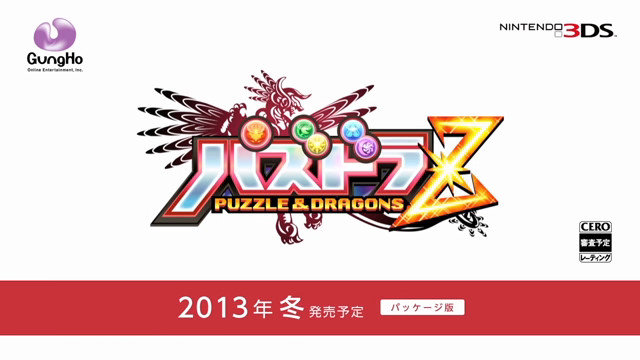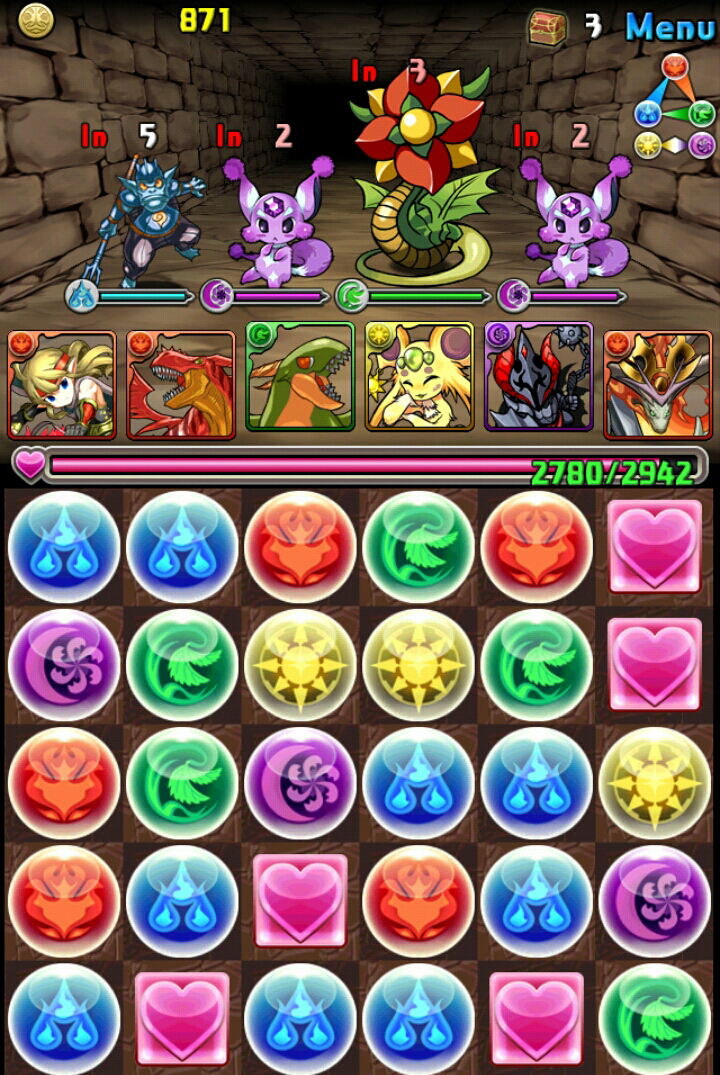
Despite having been downloaded more than a million times in North America, GungHo Online Entertainment’s RPG/puzzle blend Puzzle & Dragons, or Pazudora as it’s more commonly known in its native Japan, is still considered something of a niche title in the Western world. The game combines elements of traditional tile-matching puzzle games such as Puyo Puyo and online favourite Bejeweled with the trading and stat-building elements of classic Japanese RPGs, topped off with a sprinkle of Pokémon-esque companion monsters to collect and trade.
The game is currently one of Japan’s most played mobile games and is almost entirely responsible for its makers’ US$763 million of total sales in the first half of 2013 alone, with more than 17 million active players in Japan today. Following on from this success, a 3DS version of the game was recently announced and is due to go on sale on December 12 this year. Reports suggest, however, that the 3DS version will be slightly different in order to protect younger gamers from the microtransaction system that the game has become synonymous with.
In Puzzle & Dragons, the player progresses through a series of dungeons in the company of a small troupe of monsters of varying elemental classes that are used to battle against the enemy creatures that appear. The game screen is divided into two: the top half showing an animated representation of stat-based battles based on attack, defence and health points à la traditional JRPGs, and a bottom “puzzle” area filled with coloured gems that must be arranged into lines of three or more to make them disappear. When a line of each particular coloured gem is cleared, the corresponding companion creature is able to attack the on-screen monsters. More busted gems and multiple lines cleared mean more successive attacks, and defeating the dungeon’s monsters rewards the players with experience points and unlocks. Simple. At least to begin with.
During the first few encounters, the game is almost too generous, handing out new toys like a tipsy Santa who just came into some cash, and the dungeon’s enemies so weak they’d fall over if stood in front of a desktop fan. But an hour or two in and the game suddenly becomes decidedly tricky. Focused, dedicated players can continue to play for free and will, ultimately, progress, but if GungHo’s first quarter net profits of US$161 million are anything to go by, a great number of people choose to make a few small in-game purchases in order to overcome the hurdles they face.
It’s these microtransactions, which many smartphone gamers may have only recently become familiar with through titles such as Jetpack Joyride and Plants Vs. Zombies 2, that are the key to GungHo’s phenomenal financial success.
As with PopCap Games’ zombie-tastic tower defence game, microtransactions are usually integrated into free-to-play titles where the player is able to purchase small booster items or exchange real-world money for in-game shortcuts to success. Plants Vs. Zombies 2 seems to have found the sweet spot between challenging entertainment and shameless monetization, and manages to be fun without feeling like the gaming equivalent of a coin-operated peep-show booth, but GungHo’s popular puzzler has been criticised (or perhaps that should be commended?) by industry figures such as game economist Ramin Shokrizade, who commented in an article written for Gamasutra in June this year that Puzzle & Dragons is in fact a “money game” almost flawlessly masquerading as a game of skill, in that it repeatedly puts the player in a bind while dangling the keys to escape behind a semi-transparent pay-wall.
But GungHo President and CEO Kazuki Morishita announced yesterday that the Nintendo 3DS version of the game, titled Puzzle & Dragons Z, will be a stand-alone package and cut out the microtransaction system entirely–something that we’re sure many parents who have watched their kids pour their pocket-money into the mobile version of the game will be pleased to hear. The game will also feature a more fleshed-out adventure mode, complete with a legitimate back-story.
“The concept this time around is for children to be able to safely enjoy the game,” Morishita said in a statement at a recent promotional event. “They will be able to buy and play the game as a complete package,” he added.
Already downloaded some two million times from the App Store and Google Play, there’s no denying that GungHo is onto a winner with Puzzle & Dragons. Whether it will be able to repeat that success when player skill comes before paid upgrades remains to be seen, but the company is aiming to shift a cool million copies of the 3DS port by the end of 2013. Another million kids transfixed by a game of fantasy beasts and magic is a slightly scary thought, but at least this time around they’ll have to learn that success cannot be bought for an additional few hundred yen.
Reference: Yahoo! Japan News Gamespot
Top image via Inside-Games (Japanese) inset image via 2shotsofgeek


 New smartphone game turns your photos of real-world cats into in-game warriors
New smartphone game turns your photos of real-world cats into in-game warriors Japanese educator embezzled $69,200 over four years to fund mobile game microtransactions
Japanese educator embezzled $69,200 over four years to fund mobile game microtransactions Tokyo University students rank the top 12 video games for cultivating smart kids
Tokyo University students rank the top 12 video games for cultivating smart kids New Resident Evil survival horror maze opens at Universal Studios Japan, no little kids allowed
New Resident Evil survival horror maze opens at Universal Studios Japan, no little kids allowed Experience the real terror of a giant monster attack with the upcoming Escape From Godzilla Game!
Experience the real terror of a giant monster attack with the upcoming Escape From Godzilla Game! Red light district sushi restaurant in Tokyo shows us just how wrong we were about it
Red light district sushi restaurant in Tokyo shows us just how wrong we were about it McDonald’s new Happy Meals offer up cute and practical Sanrio lifestyle goods
McDonald’s new Happy Meals offer up cute and practical Sanrio lifestyle goods Japanese ramen restaurants under pressure from new yen banknotes
Japanese ramen restaurants under pressure from new yen banknotes Japan’s massive matcha parfait weighs 6 kilos, contains hidden surprises for anyone who eats it
Japan’s massive matcha parfait weighs 6 kilos, contains hidden surprises for anyone who eats it French Fries Bread in Tokyo’s Shibuya becomes a hit on social media
French Fries Bread in Tokyo’s Shibuya becomes a hit on social media Pokémon Sleep camping suite and guestrooms coming to Tokyo Hyatt along with giant Snorlax burgers
Pokémon Sleep camping suite and guestrooms coming to Tokyo Hyatt along with giant Snorlax burgers Sandwiches fit for a sumo served up in Osaka【Taste Test】
Sandwiches fit for a sumo served up in Osaka【Taste Test】 Tokyo Tsukiji fish market site to be redeveloped with 50,000-seat stadium, hotel, shopping center
Tokyo Tsukiji fish market site to be redeveloped with 50,000-seat stadium, hotel, shopping center Beautiful Ghibli sealing wax kits let you create accessories and elegant letter decorations【Pics】
Beautiful Ghibli sealing wax kits let you create accessories and elegant letter decorations【Pics】 Limited-edition Carbonara Udon will anger noodle purists and pasta lovers 【Taste test】
Limited-edition Carbonara Udon will anger noodle purists and pasta lovers 【Taste test】 All-you-can-drink Starbucks and amazing views part of Tokyo’s new 170 meter-high sky lounge
All-you-can-drink Starbucks and amazing views part of Tokyo’s new 170 meter-high sky lounge Studio Ghibli releases new action figures featuring Nausicaä of the Valley of the Wind characters
Studio Ghibli releases new action figures featuring Nausicaä of the Valley of the Wind characters New private rooms on Tokaido Shinkansen change the way we travel from Tokyo to Kyoto
New private rooms on Tokaido Shinkansen change the way we travel from Tokyo to Kyoto Studio Ghibli glasses cases let anime characters keep an eye on your spectacles
Studio Ghibli glasses cases let anime characters keep an eye on your spectacles Studio Ghibli releases Kiki’s Delivery Service chocolate cake pouches in Japan
Studio Ghibli releases Kiki’s Delivery Service chocolate cake pouches in Japan New definition of “Japanese whiskey” goes into effect to prevent fakes from fooling overseas buyers
New definition of “Japanese whiskey” goes into effect to prevent fakes from fooling overseas buyers Our Japanese reporter visits Costco in the U.S., finds super American and very Japanese things
Our Japanese reporter visits Costco in the U.S., finds super American and very Japanese things Studio Ghibli unveils Mother’s Day gift set that captures the love in My Neighbour Totoro
Studio Ghibli unveils Mother’s Day gift set that captures the love in My Neighbour Totoro New Japanese KitKat flavour stars Sanrio characters, including Hello Kitty
New Japanese KitKat flavour stars Sanrio characters, including Hello Kitty More foreign tourists than ever before in history visited Japan last month
More foreign tourists than ever before in history visited Japan last month New Pokémon cakes let you eat your way through Pikachu and all the Eevee evolutions
New Pokémon cakes let you eat your way through Pikachu and all the Eevee evolutions Sales of Japan’s most convenient train ticket/shopping payment cards suspended indefinitely
Sales of Japan’s most convenient train ticket/shopping payment cards suspended indefinitely Sold-out Studio Ghibli desktop humidifiers are back so Totoro can help you through the dry season
Sold-out Studio Ghibli desktop humidifiers are back so Totoro can help you through the dry season Japanese government to make first change to romanization spelling rules since the 1950s
Japanese government to make first change to romanization spelling rules since the 1950s Ghibli founders Toshio Suzuki and Hayao Miyazaki contribute to Japanese whisky Totoro label design
Ghibli founders Toshio Suzuki and Hayao Miyazaki contribute to Japanese whisky Totoro label design Doraemon found buried at sea as scene from 1993 anime becomes real life【Photos】
Doraemon found buried at sea as scene from 1993 anime becomes real life【Photos】 Tokyo’s most famous Starbucks is closed
Tokyo’s most famous Starbucks is closed One Piece characters’ nationalities revealed, but fans have mixed opinions
One Piece characters’ nationalities revealed, but fans have mixed opinions We asked a Uniqlo employee what four things we should buy and their suggestions didn’t disappoint
We asked a Uniqlo employee what four things we should buy and their suggestions didn’t disappoint Princesses, fruits, and blacksmiths: Study reveals the 30 most unusual family names in Japan
Princesses, fruits, and blacksmiths: Study reveals the 30 most unusual family names in Japan Why do Japanese gamers spend so much more money on mobile games than anyone else?
Why do Japanese gamers spend so much more money on mobile games than anyone else? Apple still lets video game developers keep their loot box odds a secret in Japan
Apple still lets video game developers keep their loot box odds a secret in Japan We played RESIDENT EVII, aka Bioha7ard, aka Resident Evil 7, at Tokyo Game Show
We played RESIDENT EVII, aka Bioha7ard, aka Resident Evil 7, at Tokyo Game Show Japanese gamer clears entire Puyo Puyo screen in a single 47 chain combo【Video】
Japanese gamer clears entire Puyo Puyo screen in a single 47 chain combo【Video】 Legend of Zelda’s traveling Koroks set to travel to our homes as adorable plushies from Japan
Legend of Zelda’s traveling Koroks set to travel to our homes as adorable plushies from Japan New starter Pokémon and setting for upcoming Pokémon Sun and Moon games revealed 【Video】
New starter Pokémon and setting for upcoming Pokémon Sun and Moon games revealed 【Video】 Here’s how the awesome new Pokémon GO mobile game will look on your smartphone
Here’s how the awesome new Pokémon GO mobile game will look on your smartphone Is pachinko headed for extinction in Japan? Studies reveal huge drop in players, hall operators
Is pachinko headed for extinction in Japan? Studies reveal huge drop in players, hall operators New Pokémon mobile game, Pokéland, announced, immediately enters alpha testing with 134 species
New Pokémon mobile game, Pokéland, announced, immediately enters alpha testing with 134 species Japan’s “escape room” games go foreigner-friendly, into the underground
Japan’s “escape room” games go foreigner-friendly, into the underground Super Smash Bros. for Wii U will support EIGHT-PLAYER offline battles 【Video】
Super Smash Bros. for Wii U will support EIGHT-PLAYER offline battles 【Video】 The reason why Nintendo’s Super Mario smartphone game won’t have in-app purchases is brilliant
The reason why Nintendo’s Super Mario smartphone game won’t have in-app purchases is brilliant Scout Corps now accepting recruits for upcoming Attack on Titan Real Escape Games
Scout Corps now accepting recruits for upcoming Attack on Titan Real Escape Games Volunteers being sought for field test of Pokémon Go mobile game
Volunteers being sought for field test of Pokémon Go mobile game Another way to hatch your Pokémon GO eggs without taking a step: pay this company to walk for you
Another way to hatch your Pokémon GO eggs without taking a step: pay this company to walk for you
Leave a Reply